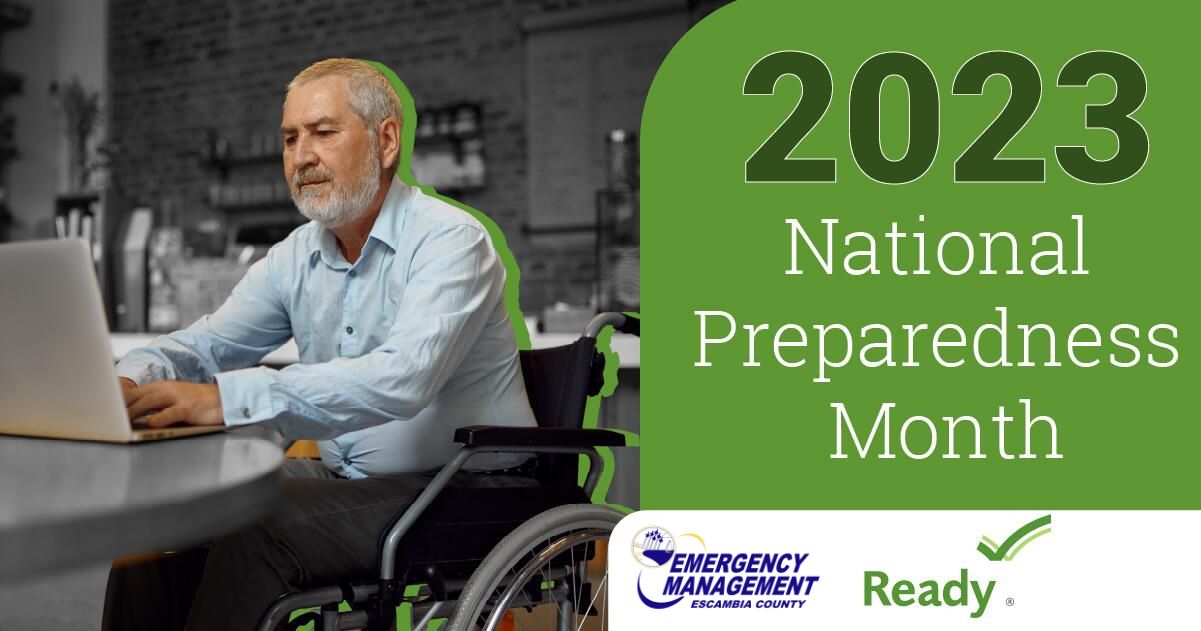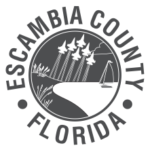
Search by Keyword
Search by Department
All Departments Administration Corrections Development Services Facilities Management Human Resources Information Technology Library Services Management and Budget Services Natural Resources Management Neighborhood and Human Services Parks and Recreation Public Safety Public Works Veterans Services Waste ServicesEscambia County encourages residents to join in observing National Preparedness Month in September, recognized each year by the Federal Emergency Management Agency to remind everyone that we all must prepare ourselves and our families for disasters now and throughout the year. This year's theme is, "Take Control in 1, 2, 3," which focuses on preparing older adults for disasters, specifically older adults from communities that are disproportionally impacted by all-hazard events.
As your prepare your home, everyone, especially older adults, are encouraged to become more prepared in three simple steps:
"If you have lived on the Gulf Coast for any length of time, you know that September and October are our area's peak hurricane months," said Emergency Manager Travis Tompkins. "There are many people moving to our area that are unaware of this. Take some time to meet neighbors, interact with people at your place of worship and talk about how you need a plan when the storm comes. Remember, it's 'One Week Ready.' Have enough food, water and supplies for a week. Check out our website for preparedness tips, and watch our 'A Minute with EM' videos on Facebook, YouTube or our website for a host of useful information and weather awareness."
Follow these steps to make sure you and your family are prepared this hurricane season:
Know Your Zone. Familiarize yourself with evacuation zones and routes. In 2018, Emergency Management released a "Know Your Zone" website for residents to look up their evacuation zone. You can look up your address to see if your home is in evacuation zone A, B, C, D, E or none as well as view the impacts of storm surge in your neighborhood. Knowing your evacuation zone is one of the most important hurricane preparation steps you can take. It is very important that you look up your evacuation zone each year to find out if and when you should evacuate, even if you have looked it up in the past, as zones can change. Most importantly, don’t rely on previous storm experience.
Know Your Home. Is your home prepared for a hurricane? With COVID-19, your safest place may be at home instead of a shelter. Pack an emergency supply kit. It should contain three days of clothes, nonperishable food, pet food, water and a battery-operated radio and flashlight with extra batteries. Also include a first-aid kit with items such as gloves, adhesive bandages and prescription medications. Find a printable disaster shopping list here. Please remember "Get One Week Ready." Citizens should be equipped to provide for themselves, their families and their pets for at least three days following a major hurricane.
Know Your Plan. Plan how you will assemble your family and loved ones, and anticipate where you will go for different situations. Get together with your family and agree on the best ways to contact one another in an emergency. Inform out-of-town family and friends of your emergency plans and stay in contact. Plan your evacuation route and destination before an evacuation order is issued. Anticipate where you and your family will go for different situations. Be sure to make preparations for pets and family members who made need special accommodations, such as a wheelchair ramp, oxygen tank or specific medications. More information on planning an evacuation for a person with disabilities or special needs is available here.
Stay Informed. Know where to go for trusted sources of information during a hurricane event. Sign up for alerts from your local emergency management office so notifications, including evacuation orders, go directly to your phone and email. You can also enable emergency alerts on your cell phones. Monitor local news for hurricane watches and warnings in your area and follow directions of local officials. Make sure you have a battery-operated or hand-crank radio available should the power go out. Review and sign up for the different types of information/notifications available directly from Escambia County.
The National Weather Service also provided some steps to follow for National Preparedness Week:
Get an Insurance Checkup: Call your insurance company or agent and ask for an insurance check-up to make sure you have enough homeowners insurance to repair or even replace your home. Don’t forget coverage for your car or boat. Remember, standard homeowners insurance doesn’t cover flooding. Whether you’re a homeowner or renter, you’ll need a separate policy for it, and it’s available through your company, agent or the National Flood Insurance Program at floodsmart.gov. Act now as flood insurance requires a 30-day waiting period.
Additional online safety resources:
More information on what to do before, during and after a storm is available online at MyEscambia.com/BeReady. You can also follow @BeReadyEscambia on Twitter, @EscambiaBeReady on Instagram, and like Escambia County Emergency Management on Facebook for the latest news and updates on emergencies impacting our community.


The mission of Escambia County government is to provide efficient, responsive services that enhance our quality of life, meet common needs and promote a safe and healthy community.
Under Florida law, IP addresses and both the content of emails and email addresses are public records. If you do not want your IP address and the content of your email or your email address released in response to a public records request, do not send electronic mail to this entity. Instead, contact this office by phone or in person.

